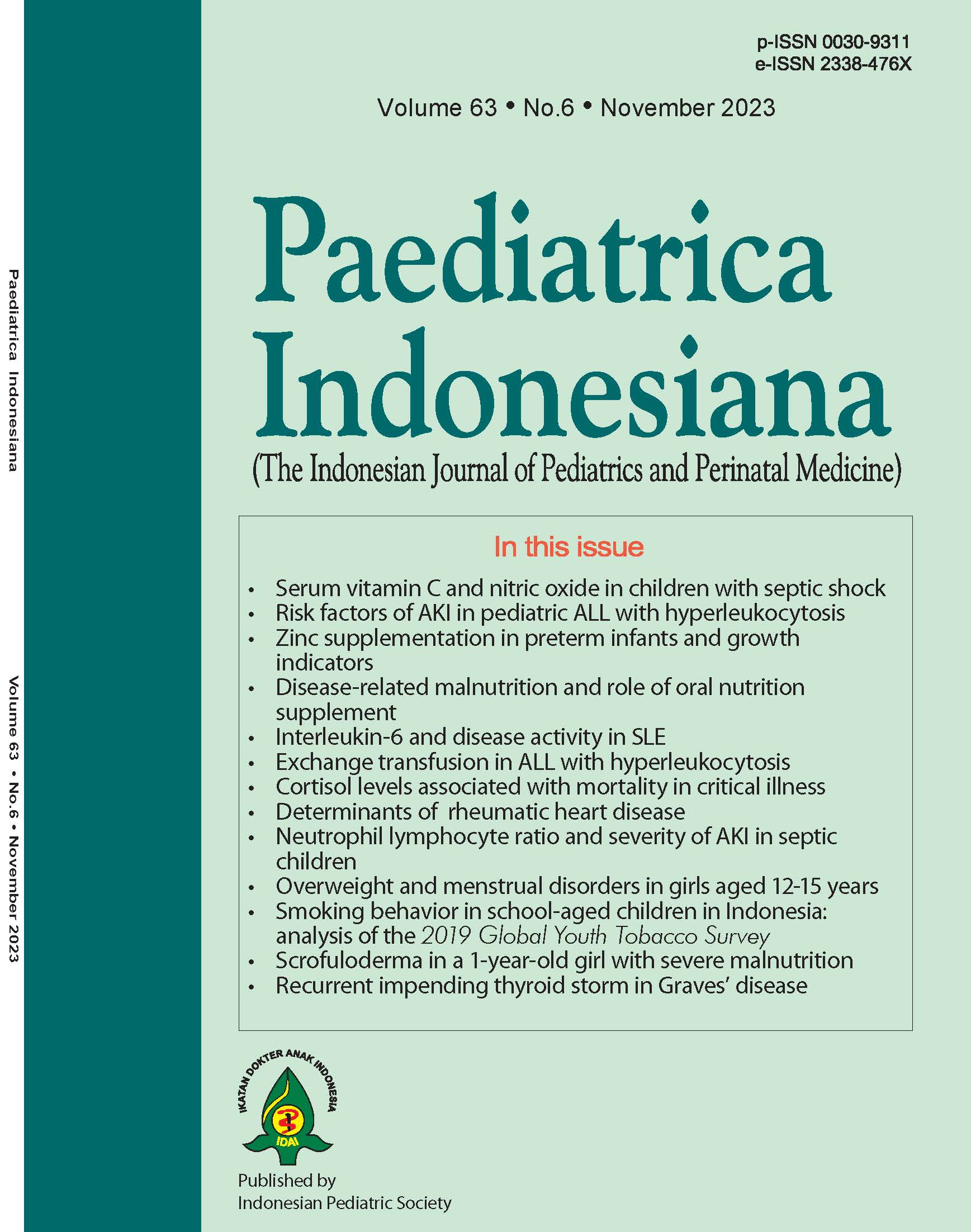A descriptive study of smoking behavior in school-aged children in Indonesia: Analysis of the 2019 Global Youth Tobacco Survey
DOI:
https://doi.org/10.14238/pi63.6.2023.506-10Keywords:
school-aged children, smoking, The Global Youth Tobacco SurveyAbstract
Background Adolescents face high pressure to participate in smoking behavior. The impact of smoking will not only affect the health of children and adolescents today, but also their later health status in adulthood. Children who start smoking at a young age are at higher risk of nicotine addiction than those who start in adulthood. Over time, this condition leads to continued cigarette consumption with age.
Objective To describe smoking behavior in school-aged children in Indonesia.
Methods This was a descriptive study using secondary data from The 2019 Global Youth Tobacco Survey (GYTS) in Indonesia. A sample of 7,582 school-aged children (13-15 years) was selected for this study. The study variables were age, sex, spending money, smoking status, age when they first started smoking, number of days of smoking within the last 30 days, average number of cigarettes per day, electric cigarette use, accessibility to electric cigarettes, and information source on electric cigarettes.
Results The largest age group in this study was 14 years old (18.21%). Most subjects were female (57.49%). One-third (2,546 children; 33.57%) of the children have tried or experimented with cigarette smoking. Out of those, 722 children (9.52%) started smoking at the age of 12-13 years and 468 children (6.17%) consumed an average of 1 cigarette per day. Two-thirds of the children were already familiar with e-cigarettes (n=6,061 or 79.94%). The e-cigarettes were obtained from other people (8.16%) and information on e-cigarettes were mostly obtained from peers (8.19%).
Conclusion a third of school-aged children in Indonesia have tried or experimented with cigarette smoking. Most of the information on cigarette smoking come from their peers.
References
2. Vilsaint MC, Green M, Xiao J, Davis K, Vallone D, Allen J, et al. American Legacy Foundation, First Look Report 13. Cigarette smoking among youth. Results from the 2002 National Youth Tobacco Survey. UCSF: Center for Tobacco Control Research and Education. 2004. [cited 2022 October 5]. Available from: https://escholarship.org/uc/item/41n8d2x8.
3. World Health Organization Regional Office for South-East Asia. Global Youth Tobacco Survey (?GYTS)? Indonesia Report, 2014. [cited 2022 October 5]. Available from: https://apps.who.int/iris/handle/10665/205148.
4. Creamer MR, Jones SE, Gentzke AS, Jamal A, King BA. Tobacco product use among high school students — Youth Risk Behavior Survey, United States, 2019. MMWR Suppl. 2020;69:56–63. DOI: https://doi.org/10.15585%2Fmmwr.su6901a7.
5. Kedar A, Gupta S. Tobacco use among adolescents and role of school in influencing this habit. Tob Induc Dis. 2021;19:A254. DOI: https://doi.org/10.18332/tid/141129.
6. US Department of Health and Human Services. Preventing tobacco use among youth and young adults: A report of the Surgeon General. US Department of Health and Human Services, Centers for Disease Control and Prevention, National Center for Chronic Disease Prevention and Health Promotion, Office on Smoking and Health, Atlanta. 2012. [cited 2022 October 05]. Available from: http://www.cdc.gov/tobacco/data_statistics/sgr/2004/complete_report/index.htm.
7. Di Franza JR, Savageau JA, Fletcher K, O’Loughlin J, Pbert L, Ockene JK, et al. Symptoms of tobacco dependence after brief intermittent use: The development and assessment of nicotine dependence in youth-2 study. Arch Pediatr Adolesc Med. 2007;161:704-10. DOI: http://dx.doi.org/10.1001/archpedi.161.7.704.
8. US Department of Health and Human Services. How Tobacco Smoke Causes Disease: The Biology and Behavioral Basis for Smoking-Attributable Disease: A Report of the Surgeon General. US Department of Health and Human Services, Centers for Disease Control and Prevention, National Center for Chronic Disease Prevention and Health Promotion, Office on Smoking and Health, Atlanta. 2010. [cited 2022 October 5]. Available from http://www.surgeongeneral.gov/library/reports/tobaccosmoke/full_report.pdf.
9. Basu M, Das P, Mitra S, Ghosh S, Pal R, Bagchi S. Role of family and peers in the initiation and continuation of smoking behavior of future physicians. J Pharm Bioallied Sci. 2011;3: 407–11. DOI: https://doi.org/10.4103%2F0975-7406.84452.
10. Sinha DN, Gupt PC, Pednekar MS. Tobacco use among students in the eight north-eastern states of India. Indian J Cancer. 2003;40:43–59. PMID: 14716119..
11. Tsering D, Pal R, Dasgupta A. Substance use among adolescent high school students, India: A survey of knowledge, attitude and opinion. J Pharm Bioall Sci. 2010;2:137–40. DOI: https://doi.org/10.4103%2F0975-7406.67005.
12. Centers for Diseases Control and Prevention. Global Tobacco Surveilance System Data (GTSSData): Datasets for South-East Asian (SEAR) Region, Indonesia, Indonesia – National. 2019. [cited 2022 October 5]. Available from https://nccd.cdc.gov/GTSSDataSurveyResources/Ancillary/DataReports.aspx?CAID=2
Downloads
Published
How to Cite
Issue
Section
License
Authors who publish with this journal agree to the following terms:
Authors retain copyright and grant the journal right of first publication with the work simultaneously licensed under a Creative Commons Attribution License that allows others to share the work with an acknowledgement of the work's authorship and initial publication in this journal.
Authors are able to enter into separate, additional contractual arrangements for the non-exclusive distribution of the journal's published version of the work (e.g., post it to an institutional repository or publish it in a book), with an acknowledgement of its initial publication in this journal.
Accepted 2023-12-15
Published 2023-12-15


















